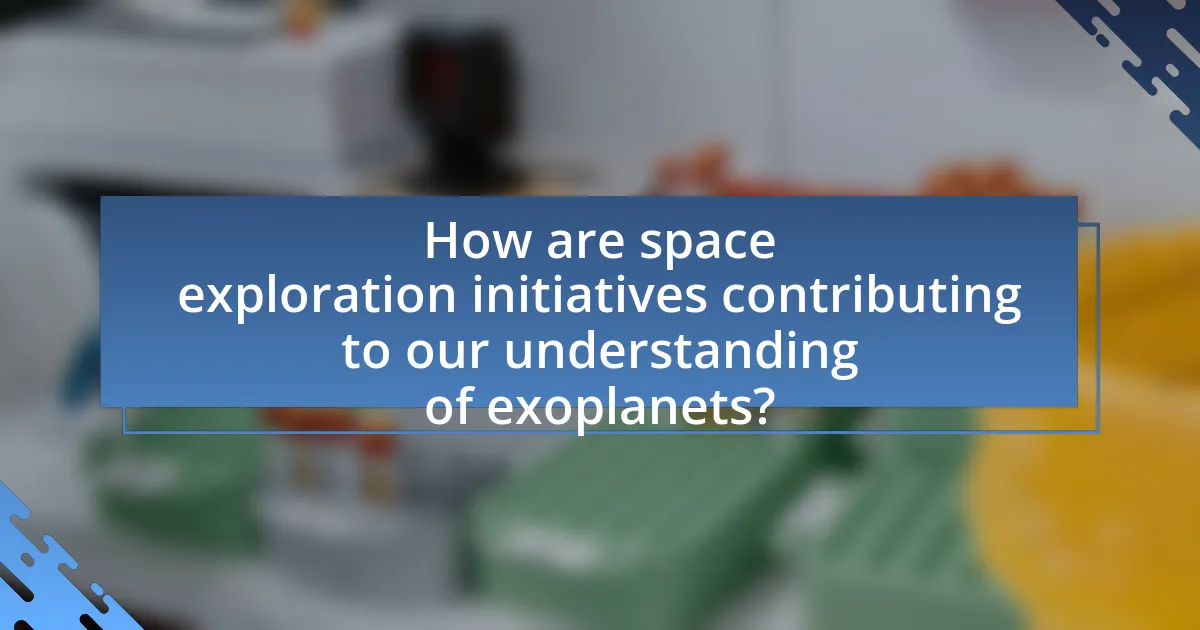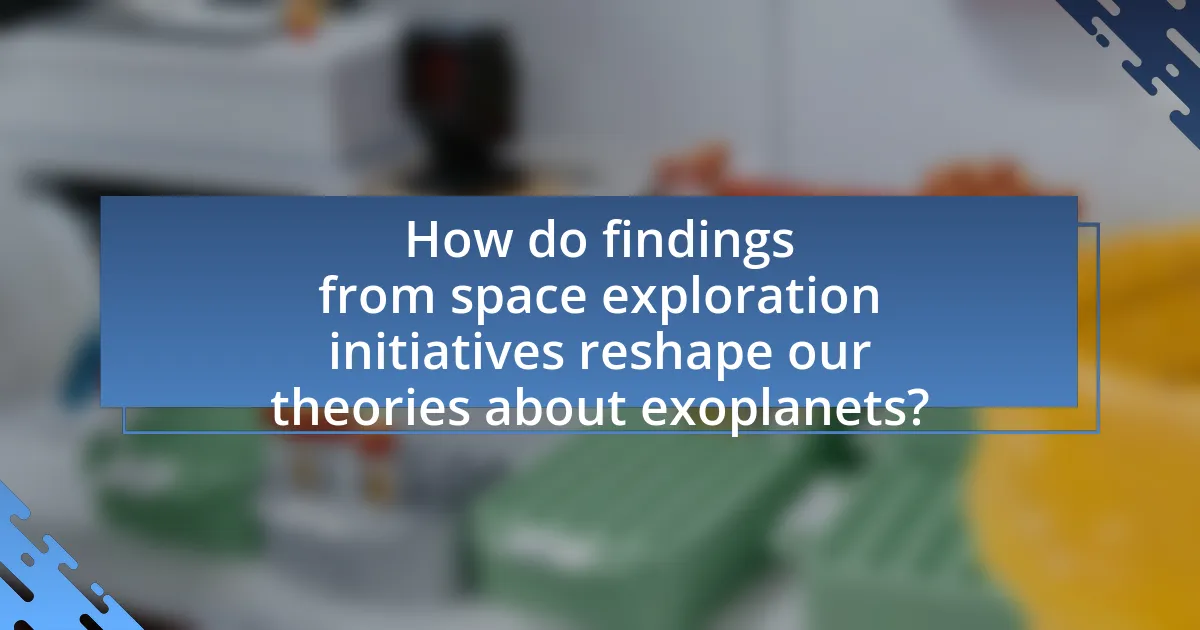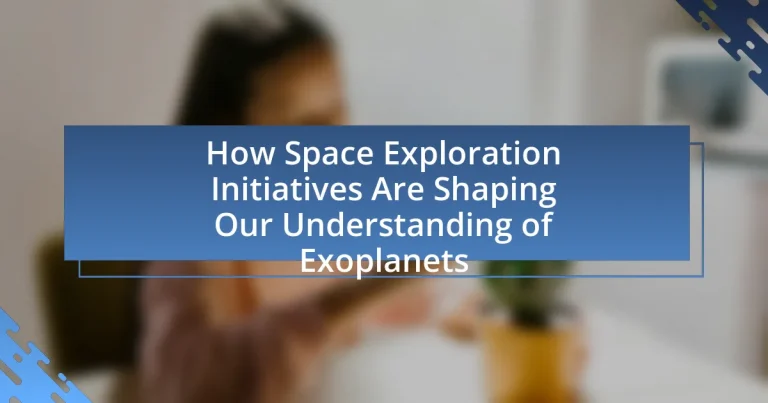Space exploration initiatives, particularly through advanced telescopes and missions, are significantly enhancing our understanding of exoplanets—planets orbiting stars outside our solar system. Key missions such as NASA’s Kepler Space Telescope and the Transiting Exoplanet Survey Satellite (TESS) have confirmed thousands of exoplanets, providing critical data on their sizes, orbits, and atmospheric compositions. These findings are reshaping theories about planetary formation and habitability, highlighting the potential for life beyond Earth. The article will explore the significance of exoplanets in space exploration, the technologies and methods used to study them, and the implications of recent discoveries for future research and exploration initiatives.

How are space exploration initiatives contributing to our understanding of exoplanets?
Space exploration initiatives are significantly enhancing our understanding of exoplanets by employing advanced telescopes and missions that directly observe and analyze these distant worlds. For instance, NASA’s Kepler Space Telescope has discovered over 2,600 confirmed exoplanets by monitoring the brightness of stars and detecting the slight dimming caused by planets transiting in front of them. Additionally, the Transiting Exoplanet Survey Satellite (TESS) is expanding this knowledge by surveying nearby stars for new exoplanets, focusing on those that may be in the habitable zone. These initiatives provide critical data on exoplanet size, orbit, and atmospheric composition, which are essential for assessing their potential for supporting life.
What are exoplanets and why are they significant in space exploration?
Exoplanets are planets that orbit stars outside our solar system. They are significant in space exploration because they provide insights into the formation of planetary systems and the potential for life beyond Earth. As of October 2023, over 5,000 exoplanets have been confirmed, with various methods such as the transit method and radial velocity method used to detect them. The study of exoplanets helps scientists understand diverse planetary environments and assess their habitability, which is crucial for future exploration missions aimed at finding extraterrestrial life.
How do scientists define and categorize exoplanets?
Scientists define exoplanets as planets that orbit stars outside our solar system. They categorize exoplanets based on various criteria, including size, composition, and orbital characteristics. For instance, exoplanets are classified into categories such as terrestrial (rocky), gas giants, and ice giants, depending on their physical properties. Additionally, scientists use the method of detection, such as transit or radial velocity, to further classify these planets. The Kepler Space Telescope, which discovered thousands of exoplanets, has significantly contributed to this categorization by providing data on their sizes and distances from their host stars, allowing for a more refined classification system.
What role do exoplanets play in the search for extraterrestrial life?
Exoplanets play a crucial role in the search for extraterrestrial life by providing potential habitats where life could exist beyond Earth. The discovery of exoplanets in the habitable zone, where conditions may allow for liquid water, increases the likelihood of finding life-sustaining environments. For instance, the Kepler Space Telescope has identified thousands of exoplanets, many of which are Earth-sized and located in their star’s habitable zone, suggesting they could support life. This data supports the hypothesis that life may be common in the universe, as it indicates that planets with conditions similar to Earth are prevalent.
What space exploration initiatives are currently focused on exoplanets?
NASA’s Transiting Exoplanet Survey Satellite (TESS) is a key initiative currently focused on exoplanets. Launched in April 2018, TESS aims to survey the entire sky for exoplanets by monitoring the brightness of stars and detecting periodic dips in light caused by orbiting planets. As of October 2023, TESS has identified thousands of potential exoplanets, significantly contributing to our understanding of planetary systems beyond our own. Additionally, the European Space Agency’s CHEOPS mission, launched in December 2019, is dedicated to characterizing known exoplanets, providing insights into their size and density, which helps in understanding their composition and potential habitability.
Which missions have successfully discovered exoplanets?
The missions that have successfully discovered exoplanets include the Kepler Space Telescope, the Transiting Exoplanet Survey Satellite (TESS), and the HARPS spectrograph. Kepler, launched in 2009, confirmed over 2,300 exoplanets through the transit method, where it observed the dimming of stars as planets passed in front of them. TESS, launched in 2018, has identified thousands of potential exoplanets by monitoring bright stars across the sky. HARPS, operational since 2003, has utilized radial velocity measurements to detect exoplanets by observing the wobble of stars caused by orbiting planets. These missions have significantly advanced our understanding of exoplanets and their characteristics.
How do telescopes and spacecraft contribute to exoplanet research?
Telescopes and spacecraft significantly enhance exoplanet research by enabling the detection and characterization of planets outside our solar system. Ground-based telescopes, such as the Keck Observatory, utilize advanced imaging techniques to identify exoplanets through methods like transit photometry and radial velocity measurements. Spacecraft like the Kepler Space Telescope have revolutionized this field by continuously monitoring thousands of stars for transits, leading to the discovery of over 2,600 confirmed exoplanets. Additionally, the James Webb Space Telescope is set to analyze the atmospheres of these planets, providing insights into their composition and potential habitability. These technological advancements facilitate a deeper understanding of planetary systems and their formation, thereby shaping our knowledge of exoplanets.
What technologies are being developed to enhance exoplanet exploration?
Technologies being developed to enhance exoplanet exploration include advanced telescopes, such as the James Webb Space Telescope, which utilizes infrared capabilities to detect exoplanet atmospheres and surface conditions. Additionally, transit photometry techniques are being refined to improve the detection of exoplanets by measuring the dimming of stars as planets pass in front of them. Furthermore, space-based observatories like the Transiting Exoplanet Survey Satellite (TESS) are designed to survey large areas of the sky for new exoplanets. These technologies collectively enable more precise measurements and greater understanding of exoplanet characteristics, thereby advancing the field of exoplanet research.
How do advanced imaging techniques improve our understanding of exoplanets?
Advanced imaging techniques enhance our understanding of exoplanets by allowing astronomers to capture detailed images and spectra of these distant worlds. These techniques, such as direct imaging and high-contrast observations, enable the detection of exoplanets that are otherwise obscured by the brightness of their host stars. For instance, the use of adaptive optics and coronagraphs has led to the successful imaging of exoplanets like HR 8799 b, c, and d, providing insights into their atmospheres and compositions. Furthermore, spectroscopy obtained through advanced imaging reveals chemical signatures, helping scientists identify the presence of water vapor, methane, and other molecules, which are crucial for assessing habitability. This combination of imaging and spectral analysis significantly deepens our knowledge of exoplanetary systems and their potential for supporting life.
What is the significance of spectroscopy in studying exoplanet atmospheres?
Spectroscopy is significant in studying exoplanet atmospheres because it allows scientists to analyze the composition and properties of these atmospheres by examining the light that passes through them. This technique enables the detection of specific chemical signatures, such as water vapor, carbon dioxide, and methane, which are crucial for understanding the potential habitability of exoplanets. For instance, the Hubble Space Telescope has successfully used spectroscopy to identify water vapor in the atmosphere of exoplanet WASP-121b, demonstrating the method’s effectiveness in revealing atmospheric constituents.

How do findings from space exploration initiatives reshape our theories about exoplanets?
Findings from space exploration initiatives significantly reshape our theories about exoplanets by providing empirical data that enhances our understanding of their formation, composition, and potential habitability. For instance, missions like Kepler and TESS have discovered thousands of exoplanets, revealing a diverse range of planetary systems that challenge previous models of planet formation. The detection of atmospheres around exoplanets, such as those observed by the Hubble Space Telescope, has led to new insights into their chemical compositions and the potential for life. Additionally, the study of exoplanetary climates through data from the James Webb Space Telescope is refining our theories on habitability by identifying key factors like temperature and atmospheric pressure. These findings collectively inform and adjust existing theoretical frameworks, making them more robust and reflective of the complexities observed in the universe.
What new insights have been gained from recent exoplanet discoveries?
Recent exoplanet discoveries have revealed the diversity of planetary systems and the potential for habitable conditions beyond Earth. For instance, the James Webb Space Telescope has identified atmospheric compositions of exoplanets, such as the presence of water vapor in the atmosphere of WASP-39b, indicating the possibility of studying climate and weather patterns on distant worlds. Additionally, the discovery of Earth-sized exoplanets in the habitable zone of their stars, like those in the TRAPPIST-1 system, suggests that rocky planets with conditions suitable for life may be more common than previously thought. These findings enhance our understanding of planetary formation and the potential for life elsewhere in the universe.
How have these discoveries challenged existing theories about planetary formation?
Recent discoveries of exoplanets, particularly those with unexpected sizes and orbital patterns, have significantly challenged existing theories about planetary formation. Traditional models suggested that planets form primarily through the gradual accumulation of dust and gas in a protoplanetary disk, leading to predictable sizes and orbits. However, the detection of “hot Jupiters,” gas giants located very close to their stars, contradicts these models, as their formation would typically require them to form further out and migrate inward. Additionally, the discovery of planets with highly eccentric orbits suggests that gravitational interactions with other celestial bodies play a more substantial role in shaping planetary systems than previously understood. These findings necessitate a reevaluation of the mechanisms driving planetary formation and migration, indicating that existing theories may be overly simplistic and require integration of new dynamics to account for the observed diversity of exoplanetary systems.
What implications do these findings have for the habitability of exoplanets?
The findings indicate that the habitability of exoplanets is significantly influenced by their atmospheric composition and distance from their host stars. Specifically, the presence of water vapor and greenhouse gases in an exoplanet’s atmosphere can create conditions conducive to life, as evidenced by the discovery of atmospheres on planets like K2-18 b, which contains both water and carbon-bearing molecules. These factors suggest that exoplanets within the habitable zone of their stars, where temperatures allow for liquid water, are more likely to support life. Additionally, studies have shown that planets with stable climates and protective magnetic fields enhance their potential for habitability, reinforcing the importance of these findings in guiding future exploration and research efforts.
How do international collaborations enhance exoplanet research?
International collaborations enhance exoplanet research by pooling resources, expertise, and data from diverse scientific communities. These partnerships enable access to advanced technologies and instruments, such as the James Webb Space Telescope, which was developed through collaboration between NASA, ESA, and the Canadian Space Agency. Collaborative efforts also facilitate large-scale observational campaigns, allowing for comprehensive studies of exoplanet atmospheres and compositions. For instance, the Transiting Exoplanet Survey Satellite (TESS) benefits from international data sharing, leading to a more extensive catalog of exoplanets. Such collaborations accelerate discoveries and foster innovation, ultimately advancing our understanding of planetary systems beyond our own.
What are some notable partnerships in space exploration focused on exoplanets?
Notable partnerships in space exploration focused on exoplanets include the collaboration between NASA and the European Space Agency (ESA) on the Cheops mission, which aims to study the characteristics of exoplanets. Another significant partnership is the joint effort of NASA and the Japan Aerospace Exploration Agency (JAXA) on the TESS mission, designed to discover new exoplanets around nearby stars. Additionally, the collaboration between the University of California, Berkeley, and various international institutions on the Kepler mission has been pivotal in identifying thousands of exoplanets. These partnerships enhance the capabilities and resources available for exoplanet research, leading to a deeper understanding of these distant worlds.
How do shared resources and data improve research outcomes?
Shared resources and data significantly improve research outcomes by facilitating collaboration and enhancing the quality of findings. When researchers share data, they can validate each other’s work, leading to more robust conclusions. For instance, the Kepler Space Telescope mission utilized shared data to allow multiple teams to analyze exoplanet candidates, resulting in the confirmation of thousands of new planets. This collaborative approach not only accelerates discovery but also reduces redundancy in research efforts, ultimately leading to more efficient use of resources and time.

What future directions can we expect in exoplanet exploration initiatives?
Future directions in exoplanet exploration initiatives include the deployment of advanced telescopes and missions aimed at characterizing exoplanet atmospheres and identifying potential biosignatures. The James Webb Space Telescope, launched in December 2021, is already providing unprecedented data on exoplanet atmospheres, while upcoming missions like the European Space Agency’s ARIEL, set to launch in 2029, will focus on studying the chemical compositions of exoplanet atmospheres. Additionally, the use of machine learning algorithms is expected to enhance data analysis, allowing for more efficient identification of exoplanets and their characteristics. These initiatives are supported by a growing body of research, including studies published in journals such as Nature Astronomy, which highlight the importance of these technologies in expanding our understanding of planetary systems beyond our own.
What upcoming missions are planned to study exoplanets?
The upcoming missions planned to study exoplanets include NASA’s James Webb Space Telescope (JWST), which is set to launch in December 2021 and will analyze the atmospheres of exoplanets, and ESA’s Ariel mission, scheduled for launch in 2029, aimed at studying the composition of exoplanet atmospheres. JWST will utilize its advanced infrared capabilities to observe distant worlds, while Ariel will focus on a large sample of exoplanets to understand their formation and evolution. These missions are critical for advancing our knowledge of exoplanets and their potential habitability.
How will these missions expand our knowledge of distant worlds?
These missions will expand our knowledge of distant worlds by utilizing advanced technologies to gather detailed data on exoplanet atmospheres, compositions, and potential habitability. For instance, the James Webb Space Telescope is designed to analyze the chemical signatures of exoplanet atmospheres, allowing scientists to identify the presence of water vapor, carbon dioxide, and other key molecules. This capability enhances our understanding of the conditions that may support life beyond Earth, as evidenced by the detection of water vapor in the atmosphere of exoplanet WASP-121b, which suggests the potential for complex chemistry. Additionally, missions like the Transiting Exoplanet Survey Satellite (TESS) are discovering new exoplanets, providing a larger sample size for study and enabling comparative analysis across different planetary systems.
What technologies are expected to emerge in future exoplanet research?
Future exoplanet research is expected to see the emergence of advanced telescopes, such as the James Webb Space Telescope and the Extremely Large Telescope, which will enhance our ability to detect and analyze exoplanet atmospheres. These telescopes utilize cutting-edge adaptive optics and infrared spectroscopy to gather detailed data on the chemical compositions of distant worlds. Additionally, technologies like starshade and coronagraphs will enable direct imaging of exoplanets by blocking out starlight, allowing for clearer observations. These advancements are supported by ongoing developments in machine learning algorithms that will improve data analysis and interpretation, facilitating the identification of potentially habitable exoplanets.
How can individuals engage with and support exoplanet exploration initiatives?
Individuals can engage with and support exoplanet exploration initiatives by participating in citizen science projects, donating to space research organizations, and advocating for space policy. Citizen science projects, such as those offered by NASA’s Planet Hunters, allow individuals to contribute to data analysis and discovery of new exoplanets. Donations to organizations like the Planetary Society directly fund research and missions aimed at exoplanet exploration. Advocacy for space policy can involve contacting representatives to support funding for NASA and other space agencies, which is crucial for ongoing research and missions. These actions collectively enhance public involvement and funding for exoplanet exploration.
What are some ways to stay informed about exoplanet discoveries?
To stay informed about exoplanet discoveries, individuals can follow scientific journals, subscribe to newsletters from space agencies, and utilize social media platforms. Scientific journals such as “The Astrophysical Journal” and “Astronomy & Astrophysics” publish peer-reviewed research on exoplanets, providing reliable and up-to-date findings. Space agencies like NASA and ESA offer newsletters and updates on their websites, detailing recent discoveries and missions related to exoplanets. Additionally, social media accounts of astronomers and institutions often share real-time information and insights, making it easier for the public to engage with the latest developments in exoplanet research.
How can citizen science contribute to exoplanet research efforts?
Citizen science can significantly contribute to exoplanet research efforts by enabling non-professionals to participate in data collection and analysis, thereby increasing the volume of observations and discoveries. Projects like Planet Hunters allow volunteers to analyze light curves from telescopes, identifying potential transits of exoplanets around stars. This collaborative approach has led to the discovery of numerous exoplanets, demonstrating that citizen contributions can complement professional astronomers’ work. For instance, the Kepler Space Telescope’s data analysis involved citizen scientists who helped confirm over 1,000 exoplanets, showcasing the effectiveness of public engagement in advancing scientific knowledge.


